
Have you checked your tyres recently?

Have you checked your tyres recently?
How often your tyres need to be replaced depends on several factors, including:
Because this wide range of factors influence the lifespan of your tyres, it’s impossible to say how many miles or years you’ll get from a set of tyres.
Instead, you should look out for certain signs when checking your tyres.
It’s advised that you check your tyres once a month to make sure they’re in good condition.
When checking your tyres, here’s what you should look out for:
It’s really easy to check your tyre’s tread depth, but if you’re not sure how, just watch our how-to video.
Your tread depth should be over 1.6mm. If your tread is below this figure, your tyres are illegal and must be replaced immediately.
However, you shouldn’t wait until your tyres reach this level. We would advise you change your tyres when the tread depth is 3 mm, before they worsen, as this is the point at which braking distances begin to be impacted.
While checking your tyres, you should also look out for signs of uneven wear across the tread pattern. This can be indicative of other problems with your tyres or your vehicle. For example, uneven wear on your tyres can be a sign of misaligned wheels.
The most common causes of avoidable tread wear are:
Cuts, breaks and abrasions can cause problems with the inner fabric of your tyre, which can be incredibly dangerous, even capable of causing high-speed blowouts. However, small punctures can often be safely repaired.
Under-inflated tyres can cause blowouts. As there is insufficient air to hold up the vehicle's weight, the sidewalls become compressed by the vehicle's weight, which means they flex over their regular limits. This can lead to a build up of heat in the tyre and significantly raises the likelihood of a blowout.
If your tyre has gone completely flat following a blowout, then the tyre has failed and you’ll need to replace it with a new one.
A bulge in the sidewall of a tyre indicates that the internal frame of the tyre has been damaged. (This could be due to driving through a large pothole or driving with low air pressure.) Driving with bulges in the sidewall dramatically increases the risk of blowout at high speeds, which can be dangerous for you and other drivers. We recommend that you replace tyres with sidewall bulges immediately.
It’s better to fit all four tyres at once to reduce uneven tyre wear.
If it’s not possible to fit all four at once, two tyres are better than one, as getting the best handling and grip on each axle is the next best option.
To be sure, make sure you ask a tyre professional before changing your tyres.
In order to make the most of your tyres, you need to look after them. This means keeping on top of some basic tyre maintenance (which is actually really easy to do).
Every month you should:
You should also carry out these checks before going on a long journey, or before towing.
Maintaining the correct pressure is one of the most important things you can do to prolong the lifespan of your tyres. This is because the tyre will wear more evenly if it is correctly inflated.
Not only will maintaining the correct pressure increase the lifespan of your tyres, it will also improve fuel efficiency.
If your tyres are wearing out fast on the outer edges, this can be an early sign of under-inflation. Take action now, as this may soon result in your tyres becoming illegal.
You can find the correct tyre pressure for your vehicle either in your owner’s handbook, in the driver’s door pillar or inside the fuel cap.
Simply use a tyre pressure gauge to check the pressure, and either inflate or deflate to suit the correct level for your vehicle.
You should rotate your tyres every 5,000–8,000 miles.
As tyres wear at different rates depending on their positioning, you can extend your tyres’ lifespan by repositioning them.
This way, all four of your tyres should wear evenly, so you can replace them all at the same time.
Spinning the wheels when you accelerate, locking them when you brake and driving at consistently high speeds will damage your tyres. Avoid this and you will get more miles out of them.
Regularly checking that your wheels are aligned is a good way to prevent uneven tyre wear.